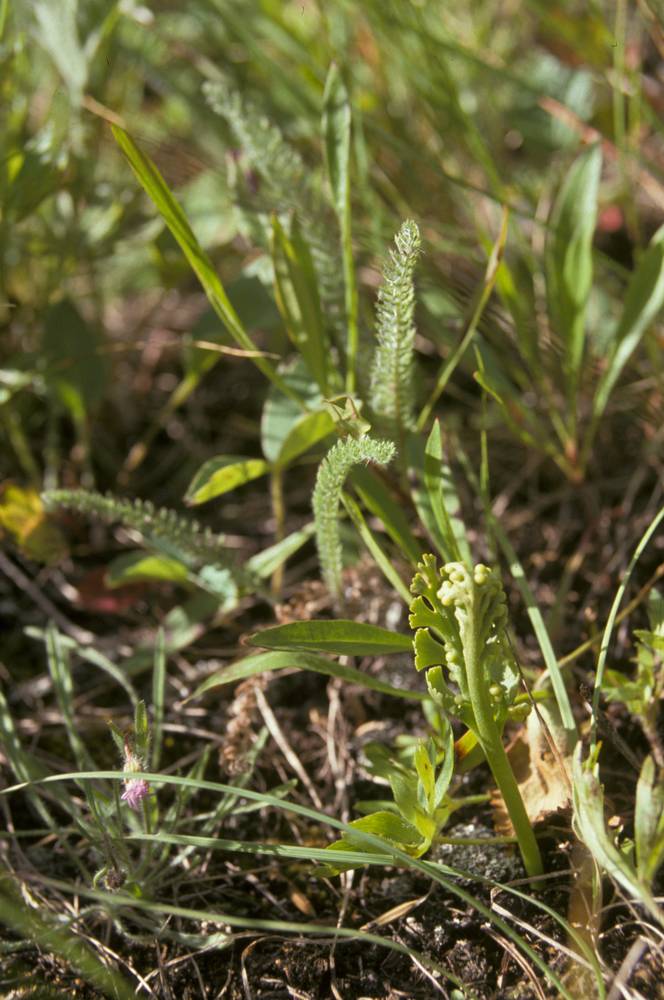Botrychium ascendens
Botrychium pinnatum
upswept moonwort
northwestern moonwort
(40)44–47(54) μm.
36– 45 μm.
well developed; greater than 2 cm, green.
well developed; greater than 2 cm except in very small plants, sometimes with a reddish brown stripe below trophophore.
sessile or short-stalked; the stalk occasionally to 2 cm long;
blade 1-pinnate, narrowly oblong-triangular; to 6 × 2 cm, yellow-green and shiny in life;
pinnae to 6 pairs, strongly ascending, narrowly fan-shaped, spanning an arc of less than 90°; broadest at the outer margin, usually coarsely toothed and with 2–5 lobes; lower pinnae often bearing marginal sporangia.
sessile or rarely with stalk to 2 mm long;
blade pinnate-pinnatifid, oblong to subdeltate; to 8 × 5 cm; grass-green and lustrous, not glaucous;
pinnae spreading or slightly ascending, approximate to overlapping; ovate to lanceolate-oblong; broadest at or below the middle, symmetrically lobed;
pinnae lobes with rounded to broadly acute apices;
sporangia rarely present on pinnae margins.
stiffly erect;
stalk 0.5–1 times as long as the trophophore at spore release, rarely longer;
branches mostly simple, strongly ascending.
erect, usually pinnately branched;
stalk 0.5–1 times as long as the trophophore at spore release.
=180 (allotetraploid, apparently derived from B. crenulatum and B. lineare).
=180 (allotetraploid, derived from B. lanceolatum and B. lunaria).
Botrychium ascendens
Botrychium pinnatum
Open, well-drained areas and historically disturbed sites with a sparse to dense cover of grasses, forbs, and small shrubs or conifer saplings, such as montane or subalpine meadows, avalanche meadows, road shoulders, ski areas, and mining disturbances. 1500–2000 m. BW. CA, ID, NV, WA; scattered in western and northeastern North America. Native.
Botrychium ascendens is easily confused with B. crenulatum, B. lineare, and B. minganense.
Moist meadows, forest openings, along small streams under shrubs or conifers, gravel road shoulders, and old clearcuts, at upper montane to subalpine elevations. 1400–3000 m. BR, BW. CA, ID, NV, WA; north to AK, southeast to AZ and NM. Native.
All reports of Botrychium boreale from North America outside of Greenland are B. pinnatum.
Ben Legler
Ben Legler
- Local floras:
BC,
CA,
OR,
WA
- Local Web sites:
CalFlora,
CalPhotos,
Flora NW,
PNW Herbaria
WildflowerSearch
iNaturalist (observations)
USDA Plants Database
- LBJ Wildflower Center
- SEINet
- Plants of the World Online
- Encyclopedia of Life
- Wikipedia
- Google Image Search
- Local floras:
BC,
CA,
OR,
WA
- Local Web sites:
CalFlora,
CalPhotos,
Flora NW,
PNW Herbaria
WildflowerSearch
iNaturalist (observations)
USDA Plants Database
- LBJ Wildflower Center
- SEINet
- Plants of the World Online
- Encyclopedia of Life
- Wikipedia
- Google Image Search





